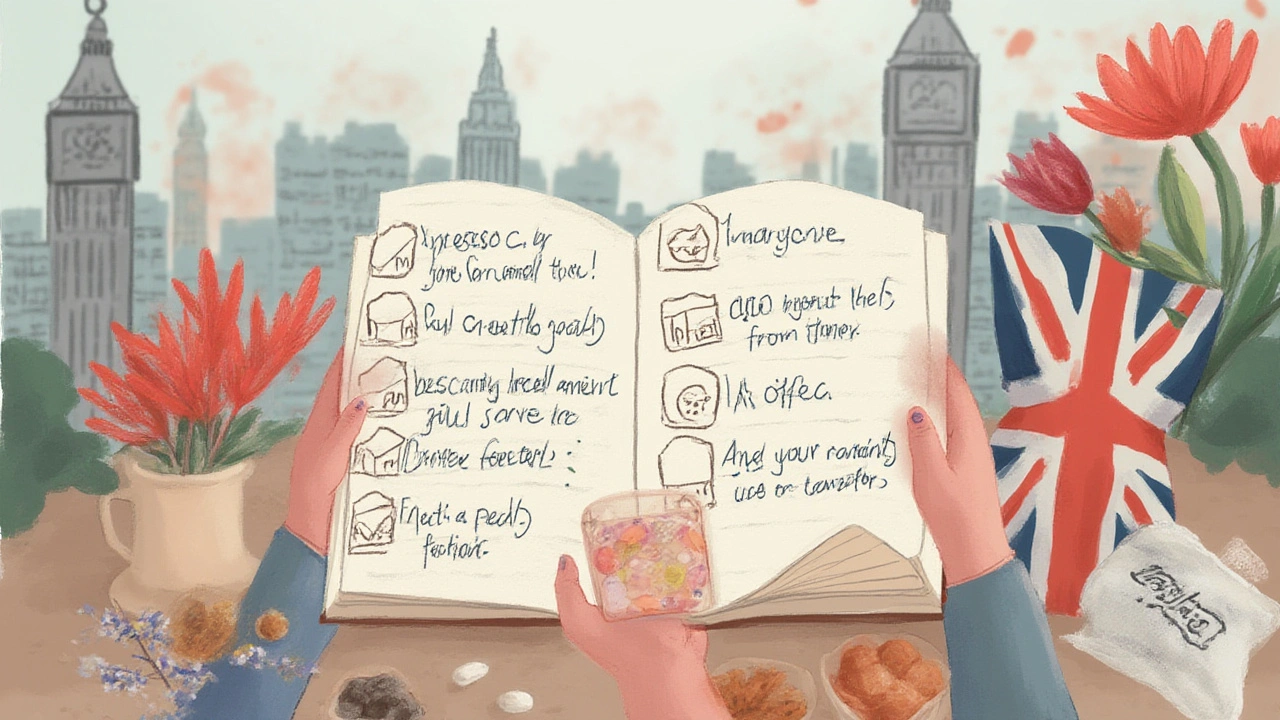Desyrel (Trazodone): Usage, Side Effects, and Key Facts for Safer Depression Treatment

You think all antidepressants are the same until one changes the way you sleep, feel, and function—without completely wrecking your energy or appetite. That’s the odd lane Desyrel (trazodone) occupies. Not your classic antidepressant, not your regular sleeping pill. It’s the med that quietly sits in a surprising number of medicine cabinets, especially if nights get long and restless or the cloud of depression won’t budge. But half the people taking it don’t even know what it actually does, or why their doctor picked it out of the dozens of options. Ever wondered why Desyrel seems to pop up so often, or why your pharmacist checks twice before handing it over? Let’s get honest about it.
What is Desyrel and How Does It Work?
Desyrel, usually recognized by its generic name trazodone, walks a weird line between mood medication and sleep helper. Developed in Italy in the 1960s, it was first meant as a new kind of antidepressant. The U.S. FDA cleared it in 1981, and since then, it’s picked up a second life treating insomnia—sometimes even more than depression.
Trazodone works by changing how serotonin, a key neurotransmitter, pings its messages between brain cells. It’s called a serotonin antagonist and reuptake inhibitor (SARI). In plain language, that means it blocks some receptors for serotonin while also helping more serotonin hang around in your brain. That cocktail softens depression's grip for many people—but with a much milder approach than heavy hitters like SSRIs or tricyclics.
But here’s a twist: Desyrel doesn’t act like a stimulant. People notice they get sleepy not wired, so it’s prescribed for those evenings when sleep just won’t come. That’s why doctors like tossing it into the mix for folks who can’t rest while fighting off worry and sadness—it kills two birds with one prescription.
At doses as low as 25-50 mg, you’ll find people taking trazodone just for sleep. At higher doses (150-400 mg), it becomes a real antidepressant. It doesn’t have the addictive risks of classic sleep aids, and it usually doesn’t make you balloon in weight or lose your sex drive as easily as some other medication heavyweights.
Trazodone isn’t used for bipolar disorder mania, and it can cause problems if mixed with other meds that affect serotonin. Not every brain reacts the same—some get groggy, dizzy, or even cranky. But that mild, multi-purpose reputation keeps Desyrel popular for treating older adults and those with complex health problems.
Common Uses: Not Just Depression
The way Desyrel is prescribed says a lot about real-life mental health. Officially, it’s for depression. Unofficially, it does much more. It’s a go-to solution when someone with depression just can’t sleep, and the doctor doesn’t want to risk stronger sedatives.
You won’t usually see Desyrel as the very first drug for depression in 2025. Most clinics reach for SSRIs or SNRIs first, just because they’re so widely used and easy to monitor. But when those tank sleep, raise anxiety, or mess with intimacy, Desyrel gets a second look.
Here’s a little-known detail: It’s also prescribed for anxiety disorders, PTSD, obsessive-compulsive disorder (OCD), and even fibromyalgia when chronic pain and poor sleep feed off each other. Some sleep specialists use it off-label for people with nightmares from trauma, especially veterans. A 2022 clinical trial found trazodone reduced nightmare frequency in veterans with PTSD by almost 40% within two months of use. That's not magic, but it’s better than nothing for folks desperate for rest.
Some kidney or cancer patients get it for insomnia, and doctors respect its relative safety for older adults, since other sedating drugs put seniors at risk for falls. Trazodone is even found in some detox centers, as a sleep aid when folks come off substances that mess with rest.
What it’s not? A quick-fix or "happy pill"—trazodone’s antidepressant effect can take two to four weeks to show up, and the sleepiness hits much sooner. That’s both good and bad: your brain might feel foggy at first, but eventually the impact on mood emerges. It’s also not addictive like benzodiazepines (the classic sleeper/tranquilizers), so you won’t crave it or build up wild tolerance like with Ambien or Xanax.

Dosage, Safety, and What to Expect
The way trazodone is dosed matters. Most people start on very low doses—maybe 25 mg or 50 mg—usually at night, because the drowsiness can hit hard. For depression, doctors often ratchet up the dose slowly, aiming for 150-300 mg, sometimes split over the day. That way you get either a sleep benefit or a true antidepressant effect, or both.
The golden rule? Never just stop taking Desyrel. Suddenly quitting can cause withdrawal symptoms: anxiety, agitation, insomnia, and a weird sensation sometimes called "brain zaps." Always taper off under supervision if you need to quit.
Here's a quick table breaking down common dosing guidelines:
| Condition | Starting Dose | Typical Range |
|---|---|---|
| Insomnia | 25-50 mg at bedtime | Up to 100 mg nightly |
| Depression | 75-150 mg/day | 150-300 mg/day (sometimes up to 400 mg) |
Tips for making things smoother:
- Take trazodone right before you want to sleep—its onset is about 30-60 minutes.
- Eat a light snack if it upsets your stomach. Some people get nauseous on an empty stomach.
- If you get dizzy or feel faint standing up, move slowly—Desyrel can lower blood pressure.
- Don’t mix with alcohol, other sedatives, or street drugs. The combo can multiply drowsiness or make breathing slow down dangerously.
- Report new or unusual feelings, agitation, suicidal thoughts, or allergic reactions ASAP—especially within the first few weeks.
The medication label says not to drive or operate machinery until you’re sure how **Desyrel** affects you. A few people stay groggy the whole next day, but others adapt after a week or two. The grogginess often fades if you or your doctor adjust the dose.
Trazodone is usually safe, but it’s not for everyone. Kids, pregnant women (unless the benefit truly outweighs the risk), and people with heart rhythm problems need extra caution. The rare but serious risk? Priapism—a prolonged, painful erection that needs urgent attention. While it sounds odd, it’s a medical emergency and happens in a tiny fraction of men taking trazodone.
Desyrel Side Effects: What No One Tells You
If you Google trazodone, you’ll get the usual list of side effects. But what surprises most patients is the mashup of sleepiness, lightheadedness, and the odd sort of clarity it sometimes brings. Over 60% of people report drowsiness, especially when starting out, but not everyone feels foggy all day—most adapt with steady use.
Here are the effects doctors hear about most:
- Drowsiness (the reason it’s often dosed at bedtime)
- Dry mouth
- Dizziness (riskier for older people prone to falls)
- Headache
- Blurred vision
- Stuffy nose
- Nausea
- Confusion (usually if the dose is too high)
What’s less common but gets all the warnings?
- Irregular heart rhythms (arrhythmias) in people at risk
- Serotonin syndrome (agitation, muscle twitching, fever, sometimes fatal if ignored)
- Priapism in men, which, again, means you have to get medical help immediately
- Hypotension (falling blood pressure, especially right after standing up)
- Allergic reactions—rare, but look out for rash, swelling, or trouble breathing
Rarely, some users experience a paradoxical effect—they get restless, not drowsy, or feel more anxious. If trazodone makes you bounce off the walls instead of catching Zs, it could be a sign it’s not the right match.
Because the tablet can taste bitter, many people take it with a flavored drink. Some break pills in half for better control. There’s a slow-release version, but it’s not widely sold in North America right now. Crushing slow-release forms can be risky and mess with how your body absorbs the medicine, so don’t do it without a doctor’s thumbs up.
Most people stick with trazodone because it doesn’t throw their weight or sex drive around like some rival antidepressants. That said, see what your body does—everyone has a slightly different ride. And if you notice blurry vision, talk to your doc, especially if you have glaucoma.

Smart Tips and Lesser-Known Facts for Better Outcomes
For something that’s been in use for decades, trazodone fuels a swamp of internet myths. Some people think it’s a miracle insomnia cure, while others moan about "zombie mornings." Here’s the truth: it works for some, not all, and avoiding trouble is as much about timing and honesty as anything chemical.
- Stick with a routine: Trazodone leans on habit. Take it at the exact same time every night if possible, which helps your sleep schedule find a natural groove.
- If you miss a dose: Don’t double up. Just skip it and restart the next day. Doubling up can spike sedation and dizziness.
- Mixing with other meds: Always share your full medication list with your doctor or pharmacist. Trazodone interacts with a ton of drugs, especially those that also mess with serotonin (like MAOIs, certain migraine meds, or some opioids). Dangerous interactions are rare, but they’re possible.
- Keep a symptom diary: Jot down sleep timing, dreams, energy, and any weird feelings or physical changes, especially when you start or change doses. It helps you and your prescriber catch problems or adjust more smoothly.
- Don’t expect instant mood change: The sleep boost arrives quickly—sometimes after the first night—but the "lifting of depression" usually takes at least two weeks to show up. Hang in there (and clue your provider in if nothing budges).
- Hydrate well: Dry mouth and mild constipation can be brushed aside by drinking more water or eating fiber-rich foods. But if other side effects show up, don’t ignore them.
- Store properly: Trazodone doesn’t need the fridge, but stew it somewhere cool and dry. Hot and humid conditions (like a bathroom shelf) can make pills break down faster.
- Avoid abrupt changes: If you want to stop, taper with your doctor. Suddenly quitting can cause headaches, mood swings, and that "electric shock" feeling in your head.
Some interesting data: Around 20 million trazodone prescriptions are written per year in the United States alone, and nearly half are for sleep (not depression). It isn’t technically approved by the FDA for insomnia, but it's so safe and effective that doctors use it anyway.
| Year | Desyrel Prescriptions in U.S. (millions) | Main Use (%) |
|---|---|---|
| 2017 | 18 | Sleep: 48% |
| 2023 | 20 | Sleep: 52% |
One final tip. Don’t be afraid of stigma. If you’re taking Desyrel, it just means you and your doctor are problem-solving. Everybody’s chemistry is different—some folks need a boost for both mood and sleep, some just want a break from restless nights. If this med works for you, embrace it. And if it doesn’t, push for a change. Nobody should muddle through months of side effects or fog just because "that’s what they always prescribe." You do you, and lean on real facts—not internet gossip—when you work with your doctor about trazodone. Maybe sleep, and hope, are closer than you think.




alan garcia petra
I really appreciate this post shedding light on Desyrel (trazodone) and its role in treating depression. It’s important for people to understand not just the benefits but also the potential side effects to make informed decisions. From what I’ve seen, trazodone can be quite effective, especially because it sometimes helps with sleep, which is a huge part of managing depression.
However, it’s crucial that folks stick to their doctor’s prescribed dosage and report any unusual symptoms early. I've read that side effects can vary from mild dizziness to more serious issues like heart problems, so vigilance is key.
What also matters is that users don’t expect instant miracles but see this as part of a broader approach including therapy and lifestyle changes. Has anyone here tried trazodone and found it helped with their sleep cycles as well as mood?
Tammie Sinnott
Absolutely! I think it's so common that many people start on medications like trazodone and get discouraged quickly because they don’t understand the timeline for improvement. It’s not an overnight fix, and managing expectations is just as important as the actual medication.
Also, let's not overlook the fact that side effects can be frustrating, sometimes making people want to quit prematurely. Fatigue, dry mouth, or dizziness might not feel severe, but they can really impact everyday functionality.
For those starting trazodone, keeping a symptom diary can be super helpful to track what’s normal and what might signal the need to contact a healthcare provider. Does anyone else find journaling helps with staying on track during treatment?
Michelle Wigdorovitz
I'm curious about cultural differences in the perception and use of medications like Desyrel. In some communities, there’s a stigma around psychiatric meds that can discourage people from seeking or sticking to treatment. This post is a great way to normalize these conversations and encourage safer, informed use.
Also wondering about interactions with other treatments—are there noteworthy cautions around mixing trazodone with certain herbal supplements or alcohol? These subtleties can make a big difference for safety but aren't always highlighted enough.
Chris Wiseman
Ah, yes, the perennial dance between the pharmaceutical panacea and the wary patient! It’s almost poetic, isn’t it? Desyrel, a chemical chimera masquerading as hope, extends its promise like a luring lighthouse in the tempestuous sea of depression. And yet, we must ask: is the beacon truly benign, or does it cast shadows of unwelcome side effects lurking beneath the surface?
I often find that while folks eagerly embrace the narrative of a pill as the solution, they neglect the subtle nuances—those tiny footnotes in the medical leaflet that hint at dizziness, bizarre dreams, or something as cryptic as priapism. These are not mere trivialities but signposts on the winding road of treatment. The question remains: how do we strike a balance between therapeutic benefit and potential detriment? This post nudges us toward that inquiry.
Aly Neumeister
But seriously, who here has been on trazodone long enough to notice if those side effects really just fade away or if they're a constant low-key nuisance? It's one thing to read about dizziness and nausea, but living with it daily can be a whole other experience.
Sometimes, I feel like doctors hand out meds like candy without enough warning about the grind you have to go through. And what about mixing with other meds? Or caffeine? Has anyone tried combining Desyrel with other antidepressants or therapy methods?
I need to know the real-life hustle because information online is so scattered.
joni darmawan
It is imperative to approach the subject of antidepressant usage with a balanced and methodical mindset. Trazodone, for instance, serves multiple purposes not only as an antidepressant but notably as a hypnotic agent due to its sedative properties. This dual functionality invites both opportunity and caution.
Patients ought to be meticulously informed about dosage schedules, the importance of gradual dosage adjustments, and the potential for interactions, especially within polypharmacy contexts. Comprehensive monitoring by healthcare professionals is equally critical to optimize therapeutic outcomes and minimize adverse effects.
Such treatments should always be embedded within a holistic care plan, integrating psychotherapy and lifestyle modifications—a fact often understated in casual discussions.
Kim M
Honestly, I’m suspicious about how much pharma companies really want us to know about side effects. You ever feel like these meds are partly designed to keep us dependent, like they create symptoms that only more drugs can treat? 😒 I don’t trust it. Desyrel may help against depression, sure, but at what cost? Have you read about withdrawal symptoms? They don't always mention how brutal coming off can be.
And what about the “accidental” cover-ups in side effect studies? I say do your homework — ALL of it — before sneaking this stuff into your system. Don’t just follow the label blindly!
Anyone else paranoid about this pharma madness? 🙃💊
Martin Gilmore
Allow me to be perfectly clear and precise here: Desyrel's profile demands rigorous attention to prescription details and individual health variables. The frequency of overlooked contraindications is astounding and frankly reckless. We've all got to stop assuming a 'one size fits all' mindset works with medications that impact neurological function.
Maintaining strict dialogue with your physician is non-negotiable. Precision in timing, dosage, and awareness of concomitant medications can be the difference between effective therapy and catastrophic complications.
Let’s quit with the guesswork. Mental health treatment is serious and laden with nuance; we owe ourselves that much respect.
Andy V
Eh, all these fancy discussions aside, when you start on Desyrel, you gotta watch out for the overnight drowsiness—it’s no joke. I mean, you can’t be out here trying to live your normal life if you’re passing out at odd hours or feeling wiped all the time.
Side effects feel like a game of roulette sometimes—some people breeze through, others get smacked by nausea, headaches, or worse. But really, not following the medical advice, or mixing with booze? That’s a disaster waiting to happen.
Anyone else had weird dreams while taking it? Some of mine got so vivid it was like a low-budget horror show, haha.
Chris Wiseman
Indeed, the phenomenon of vivid dreams is frequently reported and represents an intriguing side effect worth pondering. Are these nocturnal experiences a mere epiphenomenon, or do they reveal deeper shifts in neurochemical balances? The psychotropic tapestry is woven with mystery, and each thread of symptom or benefit contributes to the whole.
In this dance between cure and curse, personal anecdotes become invaluable supplements to scientific data, illuminating facets that large clinical trials may miss. Wouldn’t you agree that patient narratives help shape a more humane approach to medication?
alan garcia petra
Yeah, exactly! Those personal experiences matter a lot. Sometimes the dry, clinical info feels so distant from what we actually feel every day on these meds. Hearing about vivid dreams or fatigue from real folks is what helps manage expectations and encourages patience.
I also think sharing tips on how to manage these side effects — like timing the dose before bed to reduce daytime sleepiness — is super valuable. That practical stuff isn’t always front and center in professional write-ups but can make a huge difference in quality of life while on Desyrel.
Tammie Sinnott
Great point on timing the dose! I’ve noticed that taking trazodone right before sleeping can really help transform those bizarre dreams into more restful nights, though it’s different for everyone.
What worries me, though, is the lack of long-term studies on the cognitive effects of chronic use. We often talk about short-term side effects but not how medications like Desyrel impact memory or concentration over years of use. Anyone got good experience or info on that?
joni darmawan
Longitudinal data is indeed scarce regarding trazodone’s cognitive impact, which calls for more rigorous research. Anecdotal evidence suggests that while sedation may blunt some cognitive faculties temporarily, overall cognitive function may remain preserved with appropriate dosing.
Nonetheless, patients should be monitored for any emergent cognitive changes during follow-ups, and clinicians should remain vigilant to adjust treatment strategies accordingly.
Martin Gilmore
This underscores the necessity for a clinical mindset over anecdotal reliance. Patient feedback is valuable but cannot supplant formal study protocols. The goal is to amalgamate both realms — rigorous data collection with attentive patient monitoring — to safeguard health.
Failure to do so risks therapeutic misadventures that invariably worsen patient outcomes. Every prescription is a deep responsibility.
Kim M
Okay, but let’s not forget the power dynamics at play — pharma companies vaccinate their interests with 'studies' that conveniently leave out uncomfortable stuff. Sometimes the best defense is questioning everything and advocating for transparency. 💊🔍 Not just taking things at face value.
If you decide to use Desyrel, don’t just rely on your doc. Do your research, get second opinions, and keep your eyes wide open.
Michelle Wigdorovitz
All this talk has me thinking about a holistic approach. Meds like trazodone are tools—important ones—but the more we integrate therapy, lifestyle habits, exercise, and social support, the better the overall outcomes seem to be. It’s not just about popping a pill but building a sustainable path through depression.
Would love to hear from people who combined Desyrel with therapy and how that worked out for them.